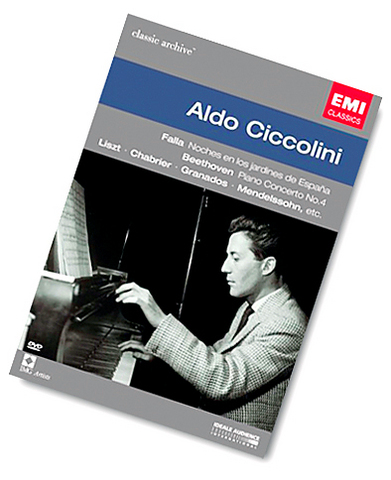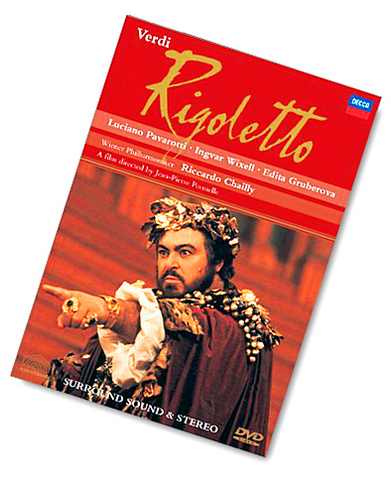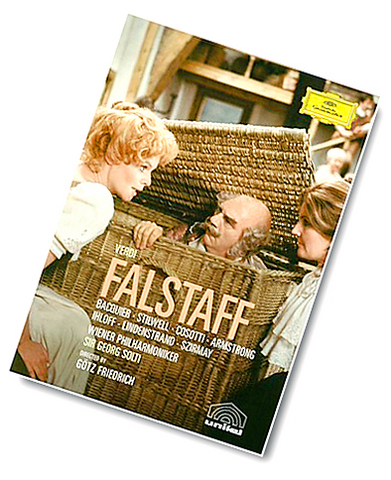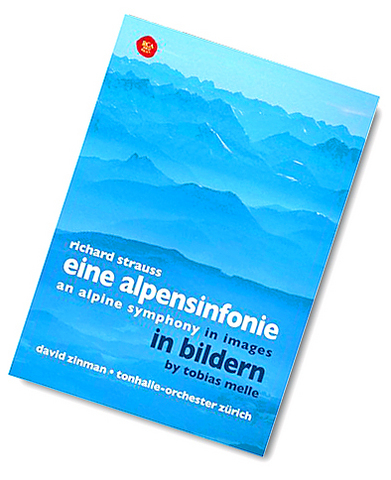This month sees the arrival on DVD of a very fine Rigoletto from the huge Unitel collection acquired last year by Deutsche Grammophon and now being released in what seem like ever more wonderful batches.
Verdi's electrifying re-telling of Victor Hugo's original story makes Rigoletto one of the great 19th century masterpieces. With echoes of Shakespeare's Macbeth and King Lear, it's far more than the vulgar melodrama some have judged it to be. There isn't a dull note anywhere, and this film version by Jean-Pierre Ponnelle matches the composer's endless inventiveness with images almost equally sensational. It's true there are over-the-top ideas (a white rat among the grapes in Act One, Gilda being carried shoulder-high onto the Duke's bed), but essentially this is a colorful and full-blooded film that is beautifully sung and played into the bargain.
Pavarotti in 1983 looks young and devilish beyond belief, and proves a better actor than perhaps he has ever been before or since. Edita Gruberova isn't a born Gilda but she sings exce-llently nevertheless. And Ingvar Wixell's Rigoletto (he also sings Monterone) is full of character, from his tow-like blond hair downwards. The settings are real Italian Renaissance palaces, and one scene even looks as if it takes place in the entrance to the Vatican's Sistine Chapel, though it surely can't be. With the orchestra the Vienna Philharmonic under Riccardo Chailly, this now becomes the best Rigoletto on DVD I know.

When I listed some of my favorite opera DVDs recently Taipei Times Dec. 22, 2005], I said that the best Falstaff I'd seen was on LD and unfortunately not available in any other format. The good news is that this month sees the release of this vivid and engaging version on DVD.
As with the Rigoletto, one reason why this Falstaff is so attractive is that the film format allows pictorial realism of a kind that stage performance could never match. Thus the second scene is set out of doors, in what looks like a Tuscan (rather than an English) garden, and the final act, which takes place at night in Windsor Forest, is re-created with full verisimilitude.
Gabriel Bacquier as Falstaff may look less obese than you'd expect, but he has much else to make up for it. The women -- Karan Armstrong as Alice, Marta Szirmay as Quickly and Jutta-Renate Ihloff as Nannetta -- are all excellent, and as convincing as actors as they are resplendent as singers. Richard Stilwell makes a strong Ford and Max-Rene Cosotti a convincing Fenton. Georg Solti conducts the Vienna Philharmonic in a performance that's both dynamic and lyrical in this highly realistic, and very recommendable, film dating from 1979.

EMI's Classic Archive series has now become a veritable deluge. What it offers are largely black-and-white films of celebrity performances from the 1950s to the 1970s, though it also includes some old TV films featuring famous classical musicians of the day. Most, though, are simply concert or studio performances, usually without any explanatory or background material. One I found especially moving, I can't really say why, was Aldo Ciccoloni in Beethoven's Fourth Piano Concerto plus many solo pieces, all recorded in Paris between 1960 and 1971. In many ways it's simply piano playing, some accompanied, from long ago. And maybe it's the time-lag itself that accounts for the effect -- all those years gone, and thoughts of who I was and what I was doing when they were being recorded. Either way, it tugged at my heart-strings. It's good value, too, at 125 minutes.
For a surprising number of people, classical music and mountain scenery have a lot in common. Richard Strauss' Alpine Symphony isn't one of his most popular works but it benefits enormously from being illustrated by photos of the Alps as it is in the DVD made by Tobias Melle. I'd often noticed it in music stores and wondered what it was like, so last week I decided to buy it and see. I wasn't disappointed.
The work illustrates a day's ascent on foot in the Alps, complete with sunrise, arrival at the peak, storm, sunset, and so on. Melle, an orchestral musician himself, decided to place the music alongside hundreds of his photos of his native Berchtesgaden Alps in southern Germany. This is not the Zugspitze that Strauss himself had in mind, Melle explains in a commentary included as a bonus. But because that now has a ski-lift on the summit, he felt that the Bavarian mountains he knows, an unspoiled area with five major massifs, would be an acceptable substitute.

Most valuable is that I have come to listen to the music again, and now find it intriguing, though restrained (for Strauss). The score is played by the Tonhalle-Orchester Zurich, with David Zinman conducting. I have to admit I missed the effects possible on film, the shadows of clouds moving across mountainsides in particular. But with artistic fades between shots, plus occasional montage, the overall result is certainly more than satisfactory.


Desperate dads meet in car parks to exchange packets; exhausted parents slip it into their kids’ drinks; families wait months for prescriptions buy it “off label.” But is it worth the risk? “The first time I gave him a gummy, I thought, ‘Oh my God, have I killed him?’ He just passed out in front of the TV. That never happens.” Jen remembers giving her son, David, six, melatonin to help him sleep. She got them from a friend, a pediatrician who gave them to her own child. “It was sort of hilarious. She had half a tub of gummies,

June 23 to June 29 After capturing the walled city of Hsinchu on June 22, 1895, the Japanese hoped to quickly push south and seize control of Taiwan’s entire west coast — but their advance was stalled for more than a month. Not only did local Hakka fighters continue to cause them headaches, resistance forces even attempted to retake the city three times. “We had planned to occupy Anping (Tainan) and Takao (Kaohsiung) as soon as possible, but ever since we took Hsinchu, nearby bandits proclaiming to be ‘righteous people’ (義民) have been destroying train tracks and electrical cables, and gathering in villages

The wide-screen spectacle of Formula One gets a gleaming, rip-roaring workout in Joseph Kosinski’s F1, a fine-tuned machine of a movie that, in its most riveting racing scenes, approaches a kind of high-speed splendor. Kosinski, who last endeavored to put moviegoers in the seat of a fighter jet in Top Gun: Maverick, has moved to the open cockpits of Formula One with much the same affection, if not outright need, for speed. A lot of the same team is back. Jerry Bruckheimer produces. Ehren Kruger, a co-writer on Maverick, takes sole credit here. Hans Zimmer, a co-composer previously, supplies the thumping

Swooping low over the banks of a Nile River tributary, an aid flight run by retired American military officers released a stream of food-stuffed sacks over a town emptied by fighting in South Sudan, a country wracked by conflict. Last week’s air drop was the latest in a controversial development — private contracting firms led by former US intelligence officers and military veterans delivering aid to some of the world’s deadliest conflict zones, in operations organized with governments that are combatants in the conflicts. The moves are roiling the global aid community, which warns of a more militarized, politicized and profit-seeking trend